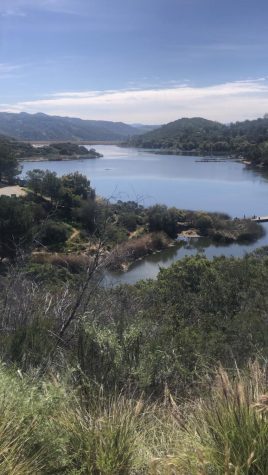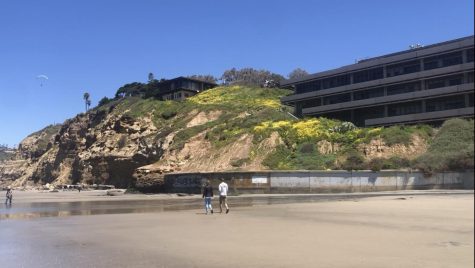Soaked SoCal
Outstanding amounts of rain and snow have been falling across Southern California. Mountain peaks are white with snow, inland valleys are coated with flowers, and coastlines have been reshaped by fierce waves. Lake reservoir water levels are the highest they’ve been in years and the drought severity has dropped to almost nonexistent in San Diego as well as Los Angeles.
While the sudden surge of storms has brought beauty to the state, it has also created many problems in everyday life. Several arid years followed by a record rainy year could be catastrophic for some regions. Rain-on-snow flooding events could also be frequent this season due to the record snowpack in the mountains.
Mountain Region
Snowfall has been blanketing the various SoCal mountain ranges, including the San Bernardino Mountains, the San Gabriel Mountains and the Laguna Mountains. Ski resorts have received more than twice their average snowfall, and there is still a month left. This record snow year has caused most mountains to extend their riding season through April.
Bear Mountain and Snow Summit average just over 100 inches of snow annually, but have over 243 inches so far this year. In addition, Snow Valley Mountain Resort averages 86 inches of snow per year and has seen roughly 190 inches this season. Many employees of the resorts and members of the mountain communities struggled to dig their way out of the snow.
“For four days I was snowed in at the resort unable to leave,” Snow Valley Employee Diane Pauley said. “Luckily, those of us who were snowed in were mainly workers and not customers.”
In March, mountain communities throughout Southern California were forced into a state of emergency due to the snowfall. Schools and businesses were shut down. Entire towns were buried and left waiting for authorities to dig them out. Residents claimed it was the harshest storm to ever hit the area.
“This is the worst year as far as snowfall I’ve ever seen,” Snow Valley Employee Ryan Marin said. “I was out of work for two weeks in early March because the storm closed all the roads and shut everything down.”

Once the snowpack melts, the surrounding lakes will benefit greatly. Mountain lakes are expecting a surge of water over the next two months. Rain will wash away most of the snow by April and May. Mudslides also present potential problems as Mother Nature transitions through Spring.
Inland Valleys
Vibrant flowers are blooming across the Southern California valleys as a result of the continuous rainfall. Hillsides are lush and overgrown. California poppies, desert lilies and fleabane daisies can be seen popping up along highways and walking trails. Locals are appreciating the colorful spring after years of drought.
“I really enjoy the yellow and orange flowers,” Grossmont Student Colton Dietrich said. “The California poppies are cool on the side of roads and nice to look at.”
San Diego has gotten over 9 inches of rain this year, which is 2 inches more than notoriously wet Seattle thus far. Unlike most years, the surrounding hills are coated green. East County San Diego resembles “back home in Ireland” to Grossmont Student Shane Farias O’Donnell.
“It’s pretty nostalgic,” O’Donnell said.
San Diego’s water reservoirs are also doing well after the wet season. Lake Miramar Reservoir is 83% full, Lake Murray Reservoir is 79.2% full and the San Vicente Reservoir is 60.5% full. The local lake’s water levels are visibly higher than in past years.
Coastal and Urban Regions
On the coast, intense weather has created massive waves capable of significantly damaging ocean cliffs. Bluffs in Blacks Beach, La Jolla, collapsed due to a large system earlier this year. Winter storms can produce waves up to 20 feet tall. In addition to the large waves, king tides raise the water line drastically. The result is large amounts of water crashing against the cliffs and sea walls. Ongoing rain has also washed sewage and bacteria into the ocean, making it unsafe to swim in at times.

Commuting through urban areas has also been an issue due to flooding. The San Diego River continues to flood its surrounding areas, reaching depths up to 10 feet in places. Crossings near Mission Valley and Fashion Valley were closed in mid-March, as well as several other times in the year. San Diego highways are not meant for this much rain, and potholes have multiplied in busy areas.
“I have a small car so it’s a little scary to drive on the freeway in all of this,” Grossmont Student Sarah Puffinburger said.
With summer on the horizon, this burst of harsh weather should finish soon. The rain replenished the state’s nature but also refueled its next fire season. Many different regions will be at risk for fires this fall due to overgrowth and dry conditions. For now, Southern Californians can relish the results of this historic winter.
Your donation will support the student journalists of Grossmont College. Your contribution will allow us to purchase equipment and cover our annual website hosting costs.

Aspiring journalist, local sports fanatic and extreme sports enthusiast. Cross-media journalism major that enjoys movies, music, video games, art and sports.











